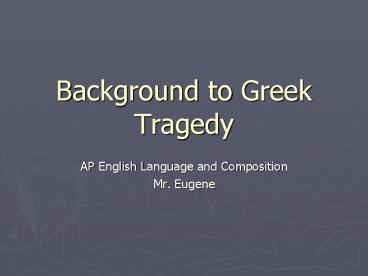Background to Greek Tragedy PowerPoint PPT Presentation
1 / 12
Title: Background to Greek Tragedy
1
Background to Greek Tragedy
- AP English Language and Composition
- Mr. Eugene
2
What is Tragedy?
- Tragedy, then, is an imitation of an action that
is serious, complete, and of a certain magnitude
in language embellished with each kind of
artistic ornament, the several kinds being found
in separate parts of the play in the form of
action, not of narrative through pity and fear
effecting the proper purgation of these emotions.
- -- Aristotle, from Book VI of the Poetics
- Analysis of definition
- Based on imitation of action that is serious,
complete, and elevated - Uses embellished language
- Presented in dramatic form
- Effects purgation (catharsis), through experience
of pity and fear in audience
3
Drama A mimetic art form
- Imitation of action is not a superficial pursuit,
but one grounded in the primitive human need to
exercise the ordering capacity of the mind on the
external world. - Mimesis often involved dance and the wearing of
costumes - Mimesis aims at inspiration and autosuggestion
- Consider these examples of artistic mimesis
- Cave painting
- Hopi rain dance
- Medieval joust
- What others can you think of?
4
History of Greek Tragedy The roots of dramatic
performance
- Greek drama was originally in
- dance form and for religious
- purposes
- Religious dances were called
- dithyrambs, or goat songs
- leaping dances of abandonment ending in sacrifice
of animal, usually a goat - Drama transitioned from religious practice to art
form in the 5th century BCE
5
The Greek Theater Architecture and Staging
D. Skene
E. Proskenion
F. Parados
A. Theatron
A. Theatron
B. Orchestra
C. Thymele
6
History of Greek Tragedy The Introduction of
Dialogue
- Thespis (a director of a famous chorus)
- Known as the first actor
- Stood on the sacrificial table and addressed
- the leader of the chorus
- Aeschylus (the Father of Tragedy)
- Introduced second actor
- Diminished the importance of the chorus
- Made dialogue the body of the drama
- Made actors as impressive as possible by
developing cothurni and painted masks
7
Sophocles The happy playwright
- Introduced second actor, scene (skene) painting,
and the play within a trilogy as an independent
entity - Raised number of chorus from 12 to 15
- First tragedian to use phrygian music
- Modified purpose of chorus
- Represented the common people
- Set the mood for each episode
- Follow the dramatic action closely
- React to the dramatic action emotionally
- Separate episodes, creating rhythmic flow
- of action and reflection
8
Euripedes
- About a dozen years younger than
- Sophocles
- From a wealthy family able to devote
- himself to drama
- Produced blends of dramatic forms,
- especially tragic-comedy
- Continued innovations in music as lyrics become
less important resulting in - Loose syntax
- Polysyllabic vagueness
- Nondramatic prologue orients viewer to the point
in the myth at which action is to begin - Extensive use of deus ex machina endings
9
Elements of Greek Tragedy Plot is the Soul of
Tragedy
- Action moves through emotion (pathos) to
perception, resulting in purgation (catharsis) - Purpose of plot is to stage a complete working
out of a single motivation - Plot must observe three unities
- Action no subplots or diversions
- Time action occurs in the space of a single day
- Place no scene changes (messenger brings news
of other events) - Plot was seldom invented usually based on known
myths - Subject is downfall of elevated figure resulting
in his destruction or death
10
Elements of Greek Tragedy Plot and the
emergence of perception
- Action of the play reveals how man is brought to
destruction by a single hamartia, or flaw in his
character - Perception emerges in the moment of peripeteia,
or reversal of action - Reversal occurs simultaneously with the moment of
anagnorisis, or recognition of the truth,
producing a change from ignorance to insight
11
Elements of Greek Tragedy Action, Perception,
and its Outcome
- Internal Tragic protagonist comes to understand
and acknowledge - his/her place in the universal scheme of things
- the errors that have led to tragedy
- the degree to which s/he is responsible for
his/her destruction - External Emotional tension increases to a
breaking point, arousing pity and fear, awe and
wonder until, at moment of reversal, audience
experiences purgation
12
Audience, religious rite, and the primitive psyche
- Audience vicariously experiences tragic emotions
in extreme form - Conclusion of tragedy purges these emotions from
the psyche - Dramatic form, in this sense, merges religious
and psychological rite - Dramatic art form is thus both inspired by and
intended to inspire the primitive psyche (see
handout on Jung) of the collective audience

